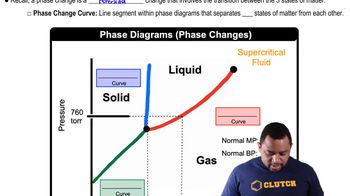Here are the essential concepts you must grasp in order to answer the question correctly.
Vapor Pressure
Vapor pressure is the pressure exerted by a vapor in equilibrium with its liquid or solid phase at a given temperature. For water at 25 °C, the vapor pressure is 23.76 torr, meaning that at this temperature, water molecules escape into the vapor phase until this pressure is reached. Understanding vapor pressure is crucial for determining whether liquid water will remain in a closed container.
Recommended video:
Raoult's Law and Vapor Pressure
Ideal Gas Law
The Ideal Gas Law relates the pressure, volume, temperature, and number of moles of a gas through the equation PV = nRT. In this context, it can be used to calculate the number of moles of water vapor that can exist in the 1.5-L container at the given vapor pressure. This helps in assessing whether the amount of water vapor will exceed the vapor pressure, indicating the presence of liquid water.
Recommended video:
Phase Equilibrium
Phase equilibrium occurs when the rates of evaporation and condensation of a substance are equal, resulting in a stable amount of liquid and vapor. In this scenario, if the amount of water vapor produced from the 1.25 g of water exceeds the vapor pressure at 25 °C, it indicates that some liquid water will remain. Understanding phase equilibrium is essential for predicting the state of matter in a closed system.
Recommended video:
Phase Changes in Diagrams



